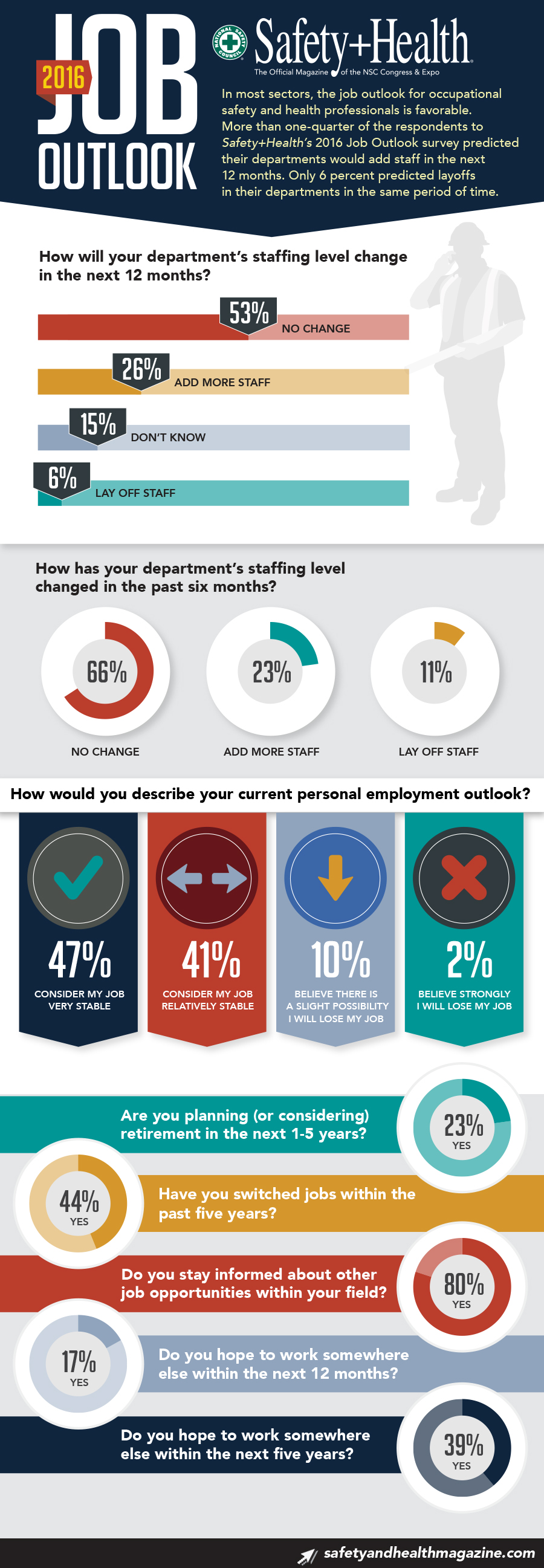2016 Job Outlook
As safety pros change jobs, new challenges arise


| Browse Job Outlook sections | Next: Lay of the land |
Previous generations of employees frequently worked at the same organization for their entire career. Loyalty was strong, both from the employer and the worker.
Nowadays, workers are more likely to change jobs multiple times during their career. Exceptions exist, of course, but changing jobs has become a fact of life in many industries – sometimes because workers choose to leave and other times because they are let go.
View the full infographic summarizing the survey findings.

How is worker safety affected by more frequent career movement among safety professionals? For Safety+Health’s 2016 Job Outlook survey, almost 800 people helped us find out, responding to questions about the status of their jobs and their organizations and whether they hoped to work somewhere else in the next five years. Most importantly, respondents provided honest, thoughtful answers to open-ended questions about whether the trend of switching jobs is here to stay – and whether that is good for safety.
Some respondents believe that a safety professional who changes jobs provides a fresh set of eyes to an organization. New safety professionals can be energized and refreshed, whereas someone in the same role for many years must guard against complacency and blind spots. New safety professionals also know what has worked – and hasn’t worked – at other sites. And they may even have more technical expertise than their predecessor.
However, most respondents said the negative effects on worker safety outweigh the positive effects when a safety professional leaves his or her position. Turnover leads to inconsistency in the safety program, respondents said, which stalls progress. An effective safety professional builds trust among workers, and if that safety professional walks away, the next person to take the job might require months or years to re-establish that trust. Lastly, many said, nothing can make up for experience on the job and in the organization.
Forty-four percent of Job Outlook respondents said they had switched jobs within the past five years. Meanwhile, 39 percent of respondents said they hope to work somewhere else within the next five years. Four out of five – 80 percent – acknowledged that they stay informed about other job opportunities within their field.
The overwhelming majority of respondents believe a more transitory workforce is here to stay. Some of the most common suggestions for organizations to keep safety professionals from seeking other employment include providing consistent leadership support, offering opportunities for advancement and assigning reasonable workloads.
 |
Infographic: The survey results summarized in one image |
Next: Lay of the land |
Post a comment to this article
Safety+Health welcomes comments that promote respectful dialogue. Please stay on topic. Comments that contain personal attacks, profanity or abusive language – or those aggressively promoting products or services – will be removed. We reserve the right to determine which comments violate our comment policy. (Anonymous comments are welcome; merely skip the “name” field in the comment box. An email address is required but will not be included with your comment.)

